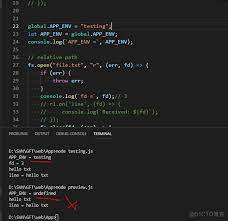Learn How to Write Files in Node

Node.js is a popular server-side JavaScript runtime environment that is widely used in web development. One of the most common tasks when working with Node.js is to read and write files. In this article, we will learn how to write files in Node.js.
When working with Node.js, we can use the built-in file system module to interact with the file system. This module provides functions for reading, writing, and manipulating files and directories.
The first step in writing a file in Node.js is to create a file. To do this, we can use the `fs.writeFile()` function. This function takes three arguments: the file name, the data to be written, and a callback function.
Here is an example of how to use the `fs.writeFile()` function:
“`javascript
const fs = require(‘fs’);
fs.writeFile(‘example.txt’, ‘Hello, world!’, function (err) {
if (err) throw err;
console.log(‘File created!’);
});
“`
In the example above, we are creating a file named “example.txt” and writing the string “Hello, world!” to it. If the file is created successfully, we will see the message “File created!” in the console.
We can also use the `fs.appendFile()` function to add data to an existing file without deleting its existing content. This function takes two arguments: the file name and the data to be appended.
Here is an example of how to use the `fs.appendFile()` function:
“`javascript
const fs = require(‘fs’);
fs.appendFile(‘example.txt’, ‘, How are you?’, function (err) {
if (err) throw err;
console.log(‘Data added!’);
});
“`
In the example above, we are adding the string “, How are you?” to the “example.txt” file. If the data is added successfully, we will see the message “Data added!” in the console.
Lastly, we can use the `fs.writeFile()` function to overwrite the contents of an existing file. This function works the same way as when creating a new file, but with an additional parameter that tells Node.js to replace the contents of the file.
Here is an example of how to overwrite a file using the `fs.writeFile()` function:
“`javascript
const fs = require(‘fs’);
fs.writeFile(‘example.txt’, ‘Hi!’, { flag: ‘w’ }, function (err) {
if (err) throw err;
console.log(‘File overwritten!’);
});
“`
In the example above, we are overwriting the contents of the “example.txt” file with the string “Hi!”. The `{ flag: ‘w’ }` parameter tells Node.js to open the file in write mode, which means its existing content will be deleted. If the file was successfully overwritten, we will see the message “File overwritten!” in the console.
In conclusion, writing files in Node.js is a common task in web development. With the built-in file system module, we can easily create, add data to, and overwrite files. By mastering these concepts, we can enhance our Node.js development skills and create more complex applications.






